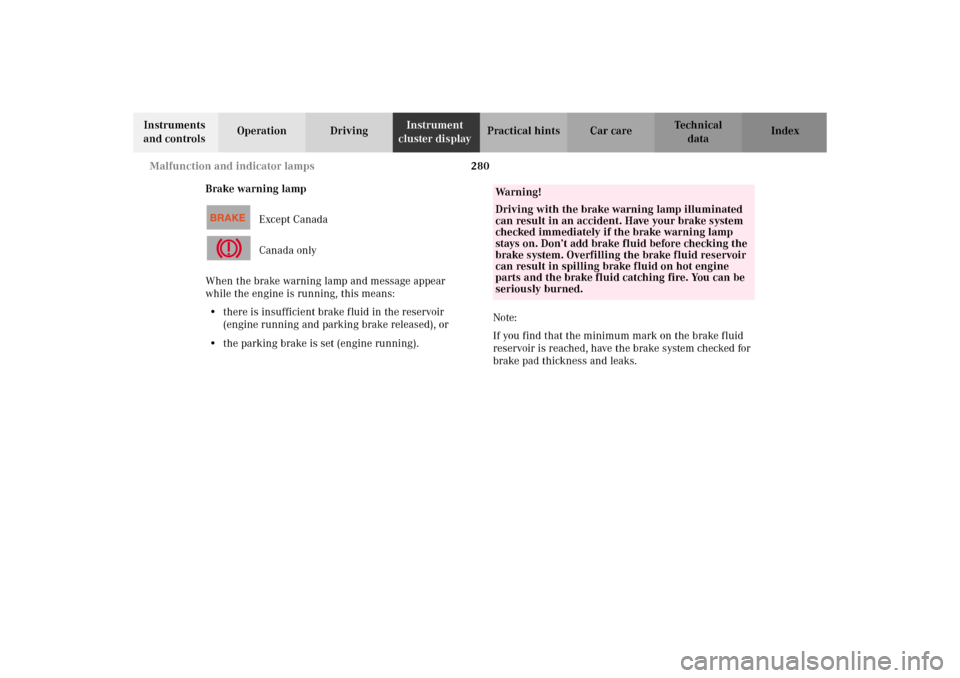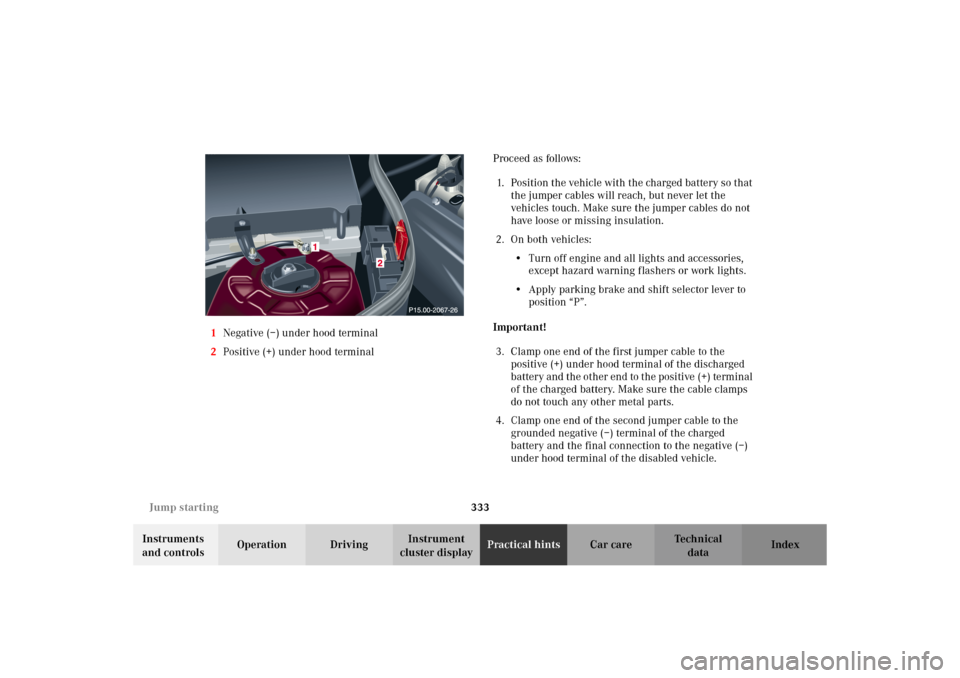Page 283 of 390

280 Malfunction and indicator lamps
Te ch n i c a l
data Instruments
and controlsOperation DrivingInstrument
cluster displayPractical hints Car care Index
Brake warning lamp
Except Canada
Canada only
When the brake warning lamp and message appear
while the engine is running, this means:
•there is insufficient brake fluid in the reservoir
(engine running and parking brake released), or
•the parking brake is set (engine running).Note:
If you find that the minimum mark on the brake fluid
reservoir is reached, have the brake system checked for
brake pad thickness and leaks.
Wa r n i n g !
Driving with the brake warning lamp illuminated
can result in an accident. Have your brake system
checked immediately if the brake warning lamp
stays on. Don’t add brake fluid before checking the
brake system. Overfilling the brake fluid reservoir
can result in spilling brake fluid on hot engine
parts and the brake fluid catching fire. You can be
seriously burned.
S203.book Seite 280 Freitag, 19. Oktober 2001 1:25 13
Page 294 of 390
291 Malfunction and warning messages
Te ch n i c a l
data Instruments
and controlsOperation DrivingInstrument
cluster displayPractical hints Car care Index PA R K I N G B R A K E
* C = Category, see page 285
SEAT BELT SYSTEM* C = Category, see page 285 Line 1 Line 2 C*
PARKING BRAKE ENGAGE BRAKE! 1
PARKING BRAKE RELEASE BRAKE! 1Line 1 Line 2 C*
SEAT BELT SYSTEM VISIT WORKSHOP! 1
PASSENGER SEAT BELT FASTEN SEAT BELT! 2
DRIVER SEAT BELT FASTEN SEAT BELT! 2
S203.book Seite 291 Freitag, 19. Oktober 2001 1:25 13
Page 324 of 390

321 Tires, Wheels
Te ch n i c a l
data Instruments
and controlsOperation DrivingInstrument
cluster displayPractical hintsCar care Index Wheels
Replace rims or tires with the same designation,
manufacturer and type as shown on the original part.
See your authorized Mercedes-Benz Center for further
information.
See your authorized Mercedes-Benz Center for
information on tested and recommended rims and tires
for summer and winter operation. They can also offer
advice concerning tire service and purchase.
Tire replacement
Front and rear tires should be replaced in sets. Rims
and tires must be of the correct size and type. For
dimensions, see “Technical Data”.
We recommend that you break in new tires for
approximately 60 miles (100 km) at moderate speed.
Wa r n i n g !
The jack is designed exclusively for jacking up the
vehi c le a t the j ack take-up b ra ckets b ui lt i nto eit her
side of the vehicle. To help avoid personal injury,
use the jack only to lift the vehicle during a wheel
change. Never get beneath the vehicle while it is
supported by the jack. Keep hands and feet away
from the area under the lifted vehicle. Always
firmly set parking brake and block wheels before
raising vehicle with jack.Do n ot d is engage parki n g brake w hil e t he vehi c le i s
raised. Be certain that the jack is always vertical
when in use, especially on hills. Always try to use
the jack on level surface. Be sure that the jack arm
is fully seated in the jack take-up bracket. Always
lower the vehicle onto sufficient capacity
jackstands before working under the vehicle.
S203.book Seite 321 Freitag, 19. Oktober 2001 1:25 13
Page 327 of 390

324 Tires, Wheels
Te ch n i c a l
data Instruments
and controlsOperation DrivingInstrument
cluster displayPractical hintsCar care Index
Changing wheelsMove vehicle to a level area which is a safe distance
from the roadway.
1. Set parking brake and turn on hazard warning
flasher.
2. Move selector lever to position “P” and turn off
engine.
3. Prevent vehicle from rolling away by blocking
wheels with wheel chocks (not supplied with
vehicle) or sizable wood block or stone. When
changing a wheel on a hill, place chocks on the
downhill side blocking both wheels of the other
axle. On an level road, place one chock in front of
and one behind the wheel that is diagonally
opposite to the wheel being changed.
Wa r n i n g !
The jack is designed exclusively for jacking up the
vehi c le a t the j ack take-up b ra ckets b ui lt i nto eit her
side of the vehicle. To help avoid personal injury,
use the jack only to lift the vehicle during a wheel
change. Never get beneath the vehicle while it is
supported by the jack. Keep hands and feet away
from the area under the lifted vehicle. Always
firmly set parking brake and block wheels before
raising vehicle with jack.
Do n ot d is engage parki n g brake w hil e t he vehi c le i s
raised. Be certain that the jack is always vertical
when in use, especially on hills. Always try to use
the jack on level surface. Be sure that the jack arm
is fully seated in the jack take-up bracket. Always
lower the vehicle onto sufficient capacity
jackstands before working under the vehicle.
S203.book Seite 324 Freitag, 19. Oktober 2001 1:25 13
Page 336 of 390

333 Jump starting
Te ch n i c a l
data Instruments
and controlsOperation DrivingInstrument
cluster displayPractical hintsCar care Index 1Negative (–) under hood terminal
2Positive (+) under hood terminalProceed as follows:
1. Position the vehicle with the charged battery so that
the jumper cables will reach, but never let the
vehicles touch. Make sure the jumper cables do not
have loose or missing insulation.
2. On both vehicles:
•Turn off engine and all lights and accessories,
except hazard warning flashers or work lights.
•Apply parking brake and shift selector lever to
position “P”.
Important!
3. Clamp one end of the first jumper cable to the
positive (+) under hood terminal of the discharged
b atter y and the ot her end to t he positive (+) te rm in al
of the charged battery. Make sure the cable clamps
do not touch any other metal parts.
4. Clamp one end of the second jumper cable to the
grounded negative (–) terminal of the charged
battery and the final connection to the negative (–)
under hood terminal of the disabled vehicle.
S203.book Seite 333 Freitag, 19. Oktober 2001 1:25 13
Page 384 of 390

381 Index
Te ch n i c a l
data Instruments
and controlsOperation DrivingInstrument
cluster displayPractical hints Car careIndex Multifunction display ...................................................... 96
Coolant temperature ................................................. 100
Engine oil level indicator ......................................... 100
FSS .............................................................................. 100
Individual settings .....................................................115
Tire inflation pressure monitor .............................. 100
Trip and main odometer .......................................... 100
Vehicle speed ............................................................. 100
Multifunction steering wheel ........................................ 96
NNavigation system ...........................................................110
Night security illumination ......................................... 140OOn-board diagnostic system .........................................278
Opening the tailgate ........................................................ 40
Overhead control panel ................................................... 21
PPanic button ......................................................................35
Parcel net in front passenger footwell ....................... 203
Parcel net in trunk ........................................................ 208
Parking brake ................................................................ 252
Power windows ............................................................... 185
Blocking of rear door window operation ............... 187
Express opening and closing .................................. 186
Opening and closing ...................................................34
Synchronizing power windows ............................... 187
Problems with your vehicle ............................................ 14
Product information .......................................................... 7RRadio
See Radio mode ......................................................... 167
Rain sensor ..................................................................... 143
Rear passenger compartment
adjustable air outlets ................................................ 160
Rear window defroster .................................................. 158
Rear window wiper/washer ......................................... 146
Removal and installation
of front seat head restraints ......................................50
S203.book Seite 381 Freitag, 19. Oktober 2001 1:25 13
Page:
< prev 1-8 9-16 17-24